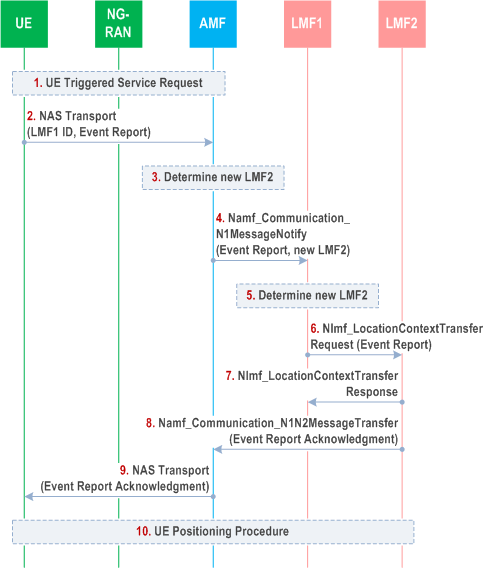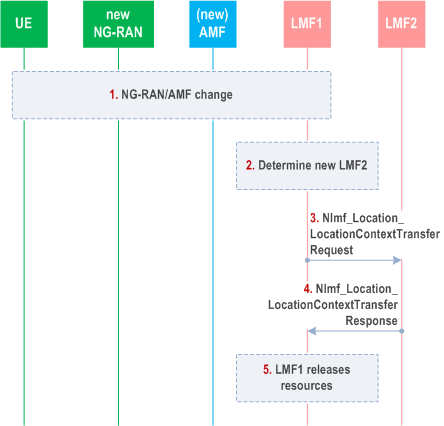Content for TS 23.273 Word version: 19.1.0
1…
4…
4.2…
4.2a…
4.3…
5…
5.5…
6…
6.1.2
6.1.3
6.1.4…
6.2
6.3…
6.3.2…
6.4
6.5…
6.7…
6.7.3
6.7.4
6.7.5
6.8
6.9…
6.10…
6.11…
6.12…
6.13…
6.14…
6.15…
6.16…
6.17…
6.18…
6.19…
6.19.2…
6.20…
6.20.4…
6.21…
7…
8…
A…
B…
C…
6.4 LMF Change Procedure p. 77
The LMF Change procedure supports change of a serving LMF during a deferred 5GC-MT-LR procedure for periodic, or triggered location events as defined in clause 6.3.1. When a serving LMF is used for the procedure in clause 6.3.1, mobility of the target UE may lead to a change of serving AMF for which the original serving LMF is not suitable. For example, the serving LMF may be very remote from the new serving AMF leading to higher resource utilisation for AMF to LMF signalling or the LMF may not be configured with information (e.g. a cell database) for the current access network for the UE to enable location. In such a case, the serving LMF may need to change. Figure 6.4-1 shows a procedure to enable change of the serving LMF when a UE sends an event report as at step 25 in clause 6.3.1.

Precondition:
Steps 1-23 in clause 6.3.1 have already been performed and steps 22-30 may have been performed or repeated. A serving LMF is used and the current serving LMF is LMF1.
Step 1.
The UE performs a service request if needed as for step 24 in clause 6.3.1.
Step 2.
The UE sends a NAS Transport message containing a supplementary services event report message to the serving AMF. The NAS Transport message includes a deferred routing identifier indicating LMF1. Step 2 corresponds to part of step 25 for clause 6.3.1.
Step 3.
Based on operator configuration and policy, the AMF may evaluate and determine that LMF1 is unsuitable or unable to support location for the current UE access network or serving cell and determines LMF2 as being a more suitable LMF. AMF may already have LMF2 information e.g. from previous NRF discovery or locally configured, otherwise AMF queries NRF and in response may get a set of LMF profiles. AMF selects new LMF (i.e. LMF2 in this case) for the current UE location based on LMF service area (consisting of one or more TA(s)) and also other information as listed in clause 5.1.
Step 4.
The AMF invokes the Namf_Communication_N1MessageNotify service operation towards LMF1. The service operation includes the event report received in step 2. If the AMF determined in step 3 that a new LMF2 should be used, it indicates that to the LMF1 as well.
Step 5.
If the AMF did not indicate a new LMF in step 4, based on the operator configuration and policy, LMF1 may evaluate and determine that it is unsuitable or unable to support location for the current UE access network or serving cell and determines LMF2 as being a more suitable LMF. LMF1 may already have LMF2 information e.g. from previous NRF discovery or locally configured, otherwise LMF1 queries NRF and in response may get a set of LMF profiles. LMF1 selects new LMF (i.e. LMF2 in this case) for the current UE location based on LMF service area (consisting of one or more TA(s)) and other information as listed in clause 5.1.
Step 6.
LMF1 invokes an Nlmf_Location_LocationContextTransfer Request service operation towards LMF2 to provide the current location context of the UE and includes the event report message received in step 4. The service operation includes the AMF identity and all the information originally received by LMF1 for the periodic or triggered location request either from the AMF according to the procedure in clause 6.3.1 or from an earlier serving LMF according to this procedure. The service operation may also include the current status of event reporting (e.g. the number of event reports so far received from the UE and/or the duration of event reporting so far) and may include location related information for the UE such a previous location estimate and the timestamp of the location estimate (if available) or location measurements.
Step 7.
LMF2 informs LMF1 of the location context transfer operation results. LMF1 then releases all resources for the procedure.
Step 8.
LMF2 invokes the Namf_Communication_N1N2MessageTransfer service operation towards the AMF to request the transfer of a supplementary services Event Report Acknowledgment message to the UE. The Event Report Acknowledgment indicates a change of LMF and includes a deferred routing identifier indicating LMF2.
Step 9.
The AMF forwards the Event Report Acknowledgment to the UE in a NAS Transport message. The AMF also informs the LMF2 of the result of the delivery of the Event Report Acknowledgement.
Step 10.
If a location estimate is needed for event reporting, LMF2 may perform positioning of the UE and determines the UE location as at step 27 in clause 6.3.1. The rest of the procedure in clause 6.3.1 then continues from step 28 with LMF2 retaining state information to enable support of subsequent event reports from the UE.
6.4.1 LMF Change Procedure for NRPPa Periodic Measurement |R19| p. 79
The LMF Change procedure supports change of a serving LMF during a deferred 5GC-MT-LR procedure for Periodic Location Events based on NRPPa Periodic Measurement. LMF change may be initiated due to new NG-RAN or new serving AMF.

Step 1.
NG-RAN or AMF change happens, e.g. due to UE mobility in CM-CONNECTED state. The (new) AMF may trigger the event notification towards LMF (e.g. based on the event subscription as described in clause 6.3.5.1).
When there is a change of AMF, the new AMF receives all event subscriptions from old AMF. The new AMF informs LMF about the new AMF address if the LMF has subscribed for the NG-RAN change event as described in clause 6.3.5.1 and the LMF reinitiates NRPPa Periodic Measurement Initiation towards new serving AMF with the remaining number of reports.
Step 2.
[Conditional] LMF1 may evaluate and determine that it is unsuitable or unable to support location for the current UE NG-RAN and determines LMF2 as being a more suitable LMF. LMF1 may already have LMF2 information e.g. from previous NRF discovery or locally configured, otherwise LMF1 queries. LMF1 selects new LMF based on NG-RAN location based and other information as listed in clause 5.1.
Step 3.
[Conditional] LMF1 invokes an Nlmf_Location_LocationContextTransfer Request service operation towards LMF2 to provide the current location context of the UE. The service operation includes the AMF identity and all the information originally received by LMF1 for the periodic location request either from the AMF or from an earlier serving LMF according to this procedure. LMF2 invokes Namf_EventExposure_Subscribe to receive events from serving AMF about NG-RAN change.
Step 4.
[Conditional] LMF2 informs LMF1 of the location context transfer operation results. LMF2 performs NRPPa Periodic Measurement Initiation.
Step 5.
[Conditional] LMF1 releases all resources for the procedure and unsubscribe from AMF event.